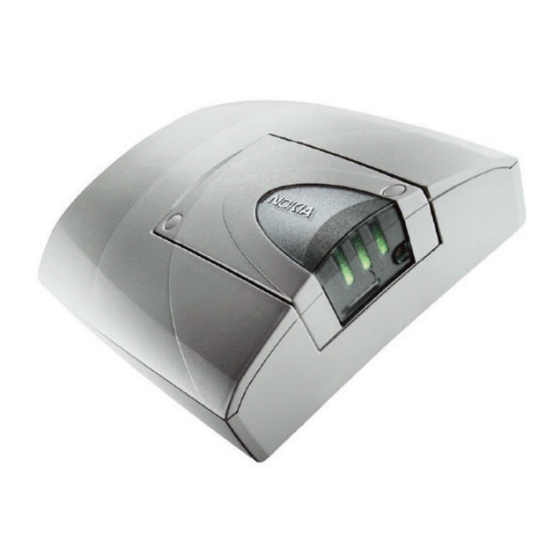Table of Contents
Advertisement
Quick Links
Advertisement
Table of Contents

Summary of Contents for Nokia 32
- Page 1 NOKIA 32 FEATURE GUIDE...
-
Page 2: Table Of Contents
CONTENTS INTRODUCTION........................ 1 FEATURE LIST........................1 SUPPLEMENTARY SERVICES ................. 1 2.1.1 HOW THE SUPPLEMENTARY SERVICES WORK..........2 2.1.1.1 Number identification ..................2 2.1.1.2 Call forwarding (Call offering)...............2 2.1.1.3 Call waiting (Call completion)...............3 2.1.1.4 In-call handling....................3 2.1.1.5 Call restriction ....................4 2.1.1.6 Security options.....................5 SMS (SHORT MESSAGE SERVICE)................. - Page 3 Nokia operates a policy of continuous development. Nokia reserves the right to make changes and improvements to any of the products described in this document without prior notice. Under no circumstances shall Nokia be responsible for any loss of data or income or any special, incidental, consequential or indirect damages howsoever caused.
-
Page 4: Introduction
INTRODUCTION This do cument goes through the main features of Nokia 32 PBX connectivity terminal. It lists the features, describes how they are used and how settings can be changed. Additional information is available also in the user’s guide and product specification of the Nokia 32 terminal, and Nokia 30 product documentation. -
Page 5: How The Supplementary Services Work
If, for example the CLIR is disabled (the phone number will be shown to the recipient of the call), invoke the CLIR by keying in #31#PhoneNumber. The phone makes a normal call to the PhoneNumber but the recipient of the call will not be able to see the Nokia 32 terminal’s phone number. -
Page 6: Call Waiting (Call Completion)
Table 2: Call forwarding functions Function Request Activation Deactivation Call forwarding; *#21# *21*PhoneNumber# ##21# Unconditional (CFU) Call forwarding; *#67# *67*PhoneNumber# ##67# Busy (CFB) Call Forwarding; *#61# *61*PhoneNumber# ##61# No reply (CFNRy) Call Forwarding; *#62# *62*PhoneNumber# ##62# Not reachable (CFNRc) • Unconditional call forwarding, also called call offering, allows incoming calls to be directed to another number (network service). -
Page 7: Call Restriction
Table 3: In-call handling functions Function Action Call in progress, release call waiting Answer call waiting, release active call Answer call waiting, hold active call Switch between active and held call Release active call Release held call Release all calls but waiting call On-hook Hold active call and set up new call R number... -
Page 8: Security Options
AT commands. A PC and a data cable are needed when using the SMS feature. Further description for using SMS (and other data services) can be found in the Nokia 30 product documentation, which is available at www.nokia.com. -
Page 9: Voice Mail
GPRS utilises packet switched technology where information is transmitted in small bursts of data. The GPRS mobile station class of the No kia 32 terminal is class B. This means that both GPRS connections and circuit switched connections are possible, although it has to be defined which one is used each time. - Page 10 Note: Nokia does not provide The CLI devices. For details and availability, contact your service provider. The CLI mode used can be changed either with Nokia 3 2 Configurator software or with a landline telephone. To change the CLI mode with Configurator software, select ‘Nokia 32’ menu in the Configurator and then ‘Line Adapter Settings’...
-
Page 11: Charge Advice Information (Cai)
The Charge Advice Information (CAI) feature indicates the cost of the most recent calls and the total of calls in an external tariff pulse counter or display. The Nokia 32 terminal converts the GSM’s standard Advice of Charge (AoC) information to Charge Advice Information (CAI) tariff pulse (12/16 kHz) information, in which case an external tariff counter or display can be used. -
Page 12: Automatic Area Code (Aac) And Routing
The Auto matic Area Code (AAC) feature allows the user to dial local numbers without a local area code in the GSM network. Before the number is sent, the Nokia 32 terminal adds a pre- programmed local area code automatically. The user can also specify the terminal to change certain prefixes automatically to provide a cost-effective route, for example. -
Page 13: Autopin Security Feature
The configuration mode is protected with a four-digit access code. When the configuration mode has been activated, the Nokia 32 terminal requests for an access code for changing the settings. The default code is 1234. To change the default access code, use the Nokia 32 Configurator Software. -
Page 14: Changing The Polarit Y Reversal Time
To change the polarity reversal time, key in 3**Polarity_Reversal_Time#. After you have keyed in the polarity reversal time the Nokia 32 terminal returns to the configuration mode. The polarity reversal time can also be changed with the Nokia 32 Configurator software (menu: Nokia 32 ->... -
Page 15: Selecting Network
To change a CLI mode, key in 4**CLI_Mode#. A more detailed configuration of the CLI functionality can be made using the Nokia 32 Configurator software (see 2.6 Calling Line Identification) 3.4 SELECTING NETWORK To select a certain network operator, a five-digit operator code must be keyed in. -
Page 16: Selecting Call Monitor Method In Extension Mode
Nokia 32 terminal answers the call and opens a line to the PBX and routes the call to a predefined extension number. The extension modes can also be changed with the Nokia 32 Configurator software (menu: Nokia 32 -> Extension Mode). - Page 17 As default, the Nokia 32 terminal monitors the busy tone (see Tone Teaching instructions in the user’s guid e or installation guide). Call monitoring method is selected with the Configurator software (menu: Nokia 32 -> Extension mode), see figure 8.
















